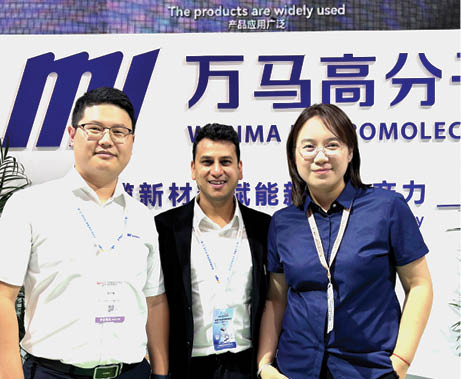In an exclusive interview with Wire & Cable India, Mr. Naval Singhal, Director & Chief Business Officer, NAVANK, highlights the company’s commitment to advancing cable compound technology to meet the stringent demands of modern infrastructure projects. Wanma has developed formulations tailored to specific markets, including India, Europe, and the Middle East. For instance, their XLPE grade complies with UL 44 and UL 1581 standards, while the LSZH-2902B/C grades meet CPR Cca classification. Additionally, the PVC grade aligns with IS 694, IS 7098, and BS 7655 standards, addressing the unique requirements of each region.

Wire & Cable India: As infrastructure projects and smart cities expand with stricter safety protocols, which of your current compounds are specifically engineered to meet cable manufacturers’ enhanced performance requirements, and what cable types or sectors are they most suited for?
Naval Singhal: Wanma offers a specialized range of flame-retardant (FR) and low smoke zero halogen (LSZH) compounds engineered to comply with stricter fire safety protocols in infrastructure and smart city projects.
Low Smoke Zero Halogen (LSZH) Compounds
These compounds minimize toxic smoke and halogen emissions during combustion, enhancing safety in fire scenarios. They offer good flame retardancy, abrasion resistance, and flexibility. LSZH compounds are used in power, control, instrumentation, and communication cables, especially in confined or high-traffic areas, smart city infrastructure like metro systems, airports, hospitals, data centers, and commercial buildings where fire safety is critical. For example, LSZH-sheathed cables are used in heavy industry and internal/external applications. Stricter safety protocols in smart cities prioritize low fire hazard materials, aligning with standards like the Construction Products Regulation (CPR) in Europe.
Cross-Linked Polyethylene (XLPE) Compounds
XLPE provides excellent electrical insulation, thermal resistance (up to 90°C), and chemical stability. It’s durable and supports high-voltage applications. Common in medium-voltage (MV) and high-voltage (HV) power cables, including single-core unarmoured cables for cathodic protection systems or hybrid cables with copper and fiber cores, these compounds are used in power distribution networks, renewable energy (solar, wind), and railway trackside power systems. For instance, XLPE solutions are used in low- to high-voltage cables for energy and infrastructure. XLPE’s reliability supports the high uptime demands of smart grids and renewable energy integration in urban projects.
Polyvinyl Chloride (PVC) Elastomer Compounds
These thermoplastic elastomers offer low-temperature flexibility, long flex life, and resistance to oils and UV exposure. Flame-retardant grades meet stringent UL standards. Used in flexible cords, control cables, and instrumentation cables, such as those for factory automation, robotics, or electric vehicle (EV) charging, these compounds find application in industrial automation, automotive (EV infrastructure), and construction sites in smart cities. Their versatility and durability suit dynamic environments where cables face repeated flexing or harsh conditions.
Polyethylene (PE) Compounds
PE offers excellent electrical insulation, moisture resistance, and chemical stability. High-density PE (HDPE) is used for sheathing, while PE insulation suits power and communication cables. PE-insulated cables for power distribution, PE-sheathed cables for outdoor or direct burial, and PE in coaxial or data cables for signal integrity, serve sectors like telecommunications, power distribution, and underground infrastructure in smart cities. PE’s durability and environmental resistance make it ideal for outdoor and underground installations in expanding urban networks.
Thermoplastic Polyurethane (TPU) and PVC/TPU Blends
TPU provides superior abrasion resistance, flexibility, and toughness. PVC/TPU blends enhance resistance to aggressive conditions like oils and chemicals. Used in jacketing for industrial cables, control cables, and material handling cables (e.g. for mining or cranes); these compounds find application in sectors like heavy industry (mining, manufacturing), material handling (ports, cranes), and smart city logistics. TPU’s robustness supports cables in mechanically demanding environments, critical for industrial smart city applications.
Ethylene Propylene Rubber (EPR) Compounds
EPR offers excellent heat resistance (up to 85°C), chemical resistance, and electrical properties, suitable for high-voltage insulation. EPR compounds are used in high-voltage power cables and rubber-insulated cables for utilities like power generation, transmission, and nuclear plants, where long service life and safety are paramount. EPR’s reliability under high temperatures and harsh conditions meets the rigorous demands of critical infrastructure.
Sustainable and Flame-Retardant Compounds
Newer compounds are RoHS-compliant, phthalate-free, and flame-retardant, with a focus on sustainability. Used in flexible power and communication cables, solar cables, and telecom cables; they serve sectors like renewable energy, telecom, and green building projects in smart cities. Their properties align with eco-friendly mandates and safety standards in sustainable urban development.
Our compounds meet stringent standards- IEC 60332-1/3 for flame propagation; IEC 61034 for smoke density; IEC 60754-1/2 for halogen acid gas emission.

Wanma’s commitment to quality is reflected in their adherence to international standards, including IEC 60502-1 and IEC 60811, which govern the physical properties and performance of cable materials.
WCI: Cable manufacturers report varying levels of success with newer compounds in high-speed production environments. How do your compounds perform in high-speed extrusion or when used with crosslinking processes like e-beam or silane grafting?
NS: Wanma’s cable compounds are engineered to excel in high-speed extrusion environments, ensuring consistent output and thermal stability even at speeds up to 1000 meters per minute. This performance is particularly crucial in modern manufacturing, where efficiency and reliability are paramount.
The company’s XLPE compounds, including silane-grafted and peroxide-crosslinked variants, are designed for smooth extrusion processes with minimal gel formation. These formulations facilitate efficient melt flow and uniform crosslinking, essential for producing high-quality cables. Additionally, Wanma’s electron beam (e-beam) ready compounds are optimized with fine dispersion of stabilizers and enhanced melt flow characteristics, making them suitable for advanced applications like automotive and solar cables.
Wanma offers a diverse range of XLPE grades tailored to specific curing methods and applications. For instance, their silane-grafted XLPE is ideal for low-voltage power cables, while peroxide-cured XLPE suits medium-voltage applications. The e-beam compatible grades are designed for photovoltaic cables, ensuring compatibility with radiation crosslinking processes. Moreover, moisture-cured XLPE grades are tailored for high-speed extrusion lines, maintaining performance under varying environmental conditions.
These compounds are processed using advanced extrusion equipment, such as twin-screw extruders, which provide high mixing efficiency and consistent output. The extrusion process is carefully controlled to prevent issues like gel formation and degradation, ensuring the production of high-quality cable insulation materials.
Wanma’s commitment to quality is reflected in their adherence to international standards, including IEC 60502-1 and IEC 60811, which govern the physical properties and performance of cable materials. By aligning their products with these standards, Wanma ensures that their compounds meet the stringent requirements of modern cable manufacturing.
Watch: Top Cable Companies in India
WCI: What breakthroughs have you made to help cable manufacturers in reducing smoke density and toxicity without compromising mechanical integrity in LSZH compounds?
NS: Wanma has made significant strides in developing Low Smoke Zero Halogen (LSZH) compounds that effectively reduce smoke density and toxicity without compromising mechanical integrity. Through extensive research and development, the company has focused on synergistic halogen-free flame retardants, particularly utilizing metal hydroxides combined with nano-scale additives. This innovative approach enhances the flame retardant properties of the compounds while maintaining their mechanical strength.
The incorporation of these advanced flame retardants results in LSZH compounds that exhibit lower smoke optical density and reduced toxicity index during combustion. Notably, these compounds also demonstrate improved vertical flame test performance by minimizing dripping behavior under fire conditions. These enhancements make Wanma’s LSZH compounds suitable for critical applications in infrastructure projects, including metro systems, tunnels, airports, electric vehicle charging stations, and industrial control cables.
Wanma’s commitment to innovation in LSZH compounds ensures compliance with stringent international standards such as IEC 61034, IEC 60754, EN 50267, and EN 50399, aligning with the industry’s growing emphasis on fire safety and environmental responsibility.
WCI: Global export markets demand varying certification standards while domestic requirements continue evolving. Are your compounds developed and certified in direct response to cable manufacturers’ compliance needs? How do you support them in regional compliance efforts?
NS: Wanma’s commitment to meeting the diverse certification requirements of global and domestic markets is evident in its comprehensive approach to product development and compliance support. The company offers a range of compounds that adhere to international standards such as UL, RoHS, REACH, CE, and the European Construction Products Regulation (CPR). These certifications ensure that Wanma’s products meet stringent safety, environmental, and performance criteria, facilitating their acceptance in various markets.
Recognizing the regional variations in compliance standards, Wanma has developed formulations tailored to specific markets, including India, Europe, and the Middle East. For instance, their XLPE-90UL grade complies with UL 44 and UL 1581 standards, while the LSZH-2902B/C grades meet CPR Cca classification. Additionally, the PVC-115/SHF grade aligns with IS 694, IS 7098, and BS 7655 standards, addressing the unique requirements of each region.
To support cable manufacturers in navigating the complexities of compliance, Wanma provides dedicated technical assistance and comprehensive documentation. This includes type test data, fire test reports, and Declarations of Performance (DoPs) for CPR compliance. Such resources are invaluable in facilitating smooth regulatory approvals and ensuring that manufacturers can meet the evolving standards of their respective markets.

The company is investing in the development of functionalized polymers that offer intrinsic flame retardancy without the need for additive loading.
WCI: The tender specification process for infrastructure projects often requires collaborative material development. Can you share a recent example where you developed or customized a compound for a cable manufacturer’s specific project or tender requirement?
NS: In 2024, Wanma collaborated closely with a cable manufacturer to develop a custom Low Smoke Zero Halogen (LSZH) sheathing compound tailored for a Middle East infrastructure tender. The project required a cable sheath capable of withstanding over 1,000 hours of xenon arc weathering and maintaining mechanical flexibility at temperatures as low as -40°C. To meet these stringent specifications, Wanma’s R&D team co-developed the LSZH-5800UV+FR grade within six weeks, ensuring both enhanced ultraviolet (UV) resistance and flame retardancy. This compound was specifically engineered for applications in oilfield and desert environments, where exposure to harsh conditions is prevalent. The successful development and field validation of this customized compound underscore Wanma’s commitment to addressing the unique challenges presented by regional infrastructure projects.
WCI: Advanced material science applications are beginning to appear in commercial cable formulations. Are you working with advanced technologies or synergistic blends that go beyond traditional compounds, specifically to enhance performance in cables?
NS: Wanma is at the forefront of integrating advanced material science into cable formulations, focusing on synergistic blends and nanocomposite technologies to enhance cable performance. The company has developed nanoclay-modified cross-linked polyethylene (XLPE) compounds, such as the XLPE-Nano125 grade, which improve dielectric strength, making them suitable for medium and high-voltage applications. In the realm of hybrid cable jackets, Wanma offers TPU/PA blends like the PA/TPU Hybrid-7800, designed to provide superior abrasion resistance and chemical durability, essential for demanding industrial environments. Additionally, Wanma is exploring the potential of self-healing materials for mission-critical cable installations, aiming to enhance the longevity and reliability of cables in harsh conditions. These innovations reflect Wanma’s commitment to advancing cable technology through the application of cutting-edge material science.
WCI: Circular economy principles are reshaping material selection processes throughout the value chain. How are you addressing environmental concerns in compounds—whether through halogen-free formulations, recyclable blends, or bio-based additives?
NS: Wanma is actively addressing environmental concerns in its cable compounds by embracing circular economy principles, focusing on halogen-free formulations, recyclable blends, and bio-based additives. The company has developed LSZH grades that are fully recyclable with minimal degradation, ensuring that end-of-life cables can be processed and reused effectively. Additionally, Wanma incorporates bio-based plasticizers and fillers in some PVC and HFFR lines, reducing reliance on fossil-derived materials and enhancing the sustainability of its products. To further support circularity, Wanma is collaborating with large OEMs to develop closed-loop reprocessing systems for cable scrap, aiming to reduce landfill contributions and promote material reuse.
Wanma’s commitment to eco-conscious compound solutions is reflected in its product offerings, such as the LSZH-BIO5800, a bio-based LSZH compound currently in the pilot stage, and the HFFR-3100R, a recyclable halogen-free flame-retardant compound. The company also provides PVC-REC105, a high-recycled content flame-retardant PVC, and PP compounds designed for a sustainable economy. These grades are developed with features like reduced CO₂ footprints, halogen-free compositions, and non-toxic byproducts, aligning with global sustainability standards. Wanma’s products comply with certifications including RoHS, REACH, Green Label, and WEEE, demonstrating its dedication to environmental responsibility and sustainable development in the cable industry.
Also Read: 3R Polymers: Exploring Synergistic Flame-retardant Systems, Nano-Additives and Polymeric Blends
WCI: The gap between laboratory certification and field performance remains a discussion point in industry forums. What kind of feedback do you typically receive from cable manufacturers regarding performance in terms of what works well, and what still needs improvement?
NS: Wanma consistently receives positive feedback from cable manufacturers regarding the performance of its compounds in real-world applications. Customers have highlighted the consistent extrusion behavior, low scorch, and minimal gel formation in XLPE and PVC grades, which contribute to efficient production processes and high-quality end products. The high batch-to-batch consistency of Wanma’s materials further aids productivity by reducing variability and ensuring reliable performance across different production runs.
Specific product grades have garnered particular praise. The XLPE-125S grade is noted for its excellent gel control and thermal aging resistance, making it suitable for demanding applications where stability over time is crucial. Similarly, the L-5700H grade has been recognized for maintaining stable flame retardancy even after prolonged outdoor exposure, ensuring continued safety and compliance with fire safety standards in challenging environmental conditions.

Wanma is integrating artificial intelligence (AI)-assisted formulation design into its research and development processes. This approach aims to accelerate R&D timelines and enhance the predictability of material properties, ensuring that new compounds meet the specific performance criteria required for advanced cable applications
WCI: Material science innovation continues driving performance advances while addressing processing challenges. From a compounder’s perspective, what’s the next big leap needed in material science to meet the cable industry’s evolving needs?
NS: Wanma is actively exploring the next frontier in material science to meet the evolving demands of the cable industry. The company is investing in the development of functionalized polymers that offer intrinsic flame retardancy without the need for additive loading. These lightweight, high-performance materials are particularly suited for applications in electric vehicles (EVs), aerospace, and robotics cables, where both safety and weight considerations are paramount. In parallel, Wanma is integrating artificial intelligence (AI)-assisted formulation design into its research and development processes. This approach aims to accelerate R&D timelines and enhance the predictability of material properties, ensuring that new compounds meet the specific performance criteria required for advanced cable applications.





